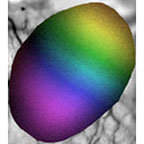
The development and organization of functional maps in cerebral cortex
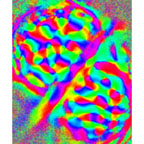
- I am interested in understanding how the sensory world is represented in the mammalian brain.
Individual neurons in sensory areas are selectively responsive to specific aspects of world- neurons in the visual cortex, for example, prefer certain orientations of edges and respond
to specific spacing of dark and bright regions. The process by which neuronal responses become
selective is constrained by both genetically determined events and by the environment to which
a young animal is exposed. How these selective response properties develop, become organized
within a sensory area, and how this organization contributes to the perception of the world are
the focus of my research.
Our current research goals are to understand how information about spatial and temporal components of a scene is encoded in the primary visual cortex. We are studying the functional organization of the visual cortex in both normal animals and in an animal model of the cortical visual pathology known as amblyopia.
The organization of visual cortex in normal vision
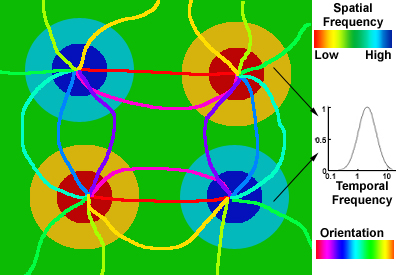
- When viewing a scene our visual system extracts information at different spatial scales.
A subset of cortical neurons responds to large-scale variations in light intensity, while others
respond selectively to fine detail within an image. In previous work, I have shown that the visual
cortex is organized to segregate information about large and small scales into physically separate
cortical domains. The organization of size (also known as spatial frequency) information has a
stereotyped relationship with features of another cortical map (the map of neuronal orientation preference),
suggesting how images with arbitrary combinations of stimulus features are efficiently represented
in small patches of cortex.
We are now investigating how the organization of spatial information is involved encoding object motion. We have developed a theoretical model for how moving objects in a visual scene are represented within the primary visual cortex. We are using intrinsic-signal imaging, a high-resolution imaging method, and electrophysiology to test this model explicitly.
How amblyopia changes the cortical organization of spatial information
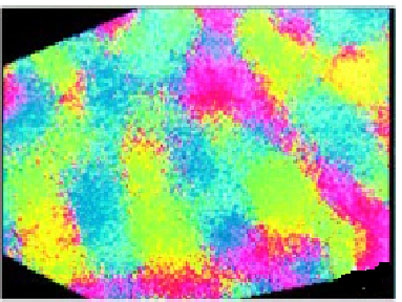

- Amblyopia is a debilitating visual disorder caused by a problem with an eye, such as a cataract, during
infancy or early childhood. While early treatment of the physical problem with the eye usually prevents
total blindness, nearly 3% of the U.S. population still suffers from some degree of amblyopia. Although
significant progress has been made in early diagnosis and treatment, amblyopia remains a major cause of
visual impairment.
Because amblyopia, once induced, persists even after correcting physical problems with the eye, it is a pathology of the central nervous system. Understanding how spatial information is disrupted in the amblyopic brain is therefore central to understanding this problem of early visual development. We are using high-resolution functional brain imaging in an animal model to study how the visual cortex changes with amblyopia. Based on our previous studies of the representation of size information in the visual cortex and the clinical manifestations of amblyopia, we predict that specific domains of the visual cortex are affected more profoundly by amblyopia than are other areas.
Developing areas of research
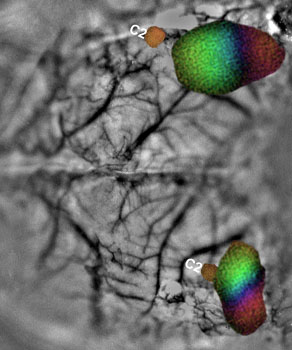
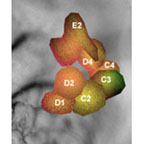
- In addition to our core interest in the functional organization of visual cortex, we are beginning to address
specific questions in other sensory systems. In preliminary work on the olfactory system, we are applying the
same experimental and analytic tools that we have used to study the visual cortex to understand how mixtures of
different odors are represented in the olfactory bulb. In collaborative work, we are assessing the effect of
specific morphogens on the development of functional organization of sensory cortex. These projects complement
our studies of the visual cortex in allowing us to generalize rules governing the functional organization of
sensory cortex and its development.